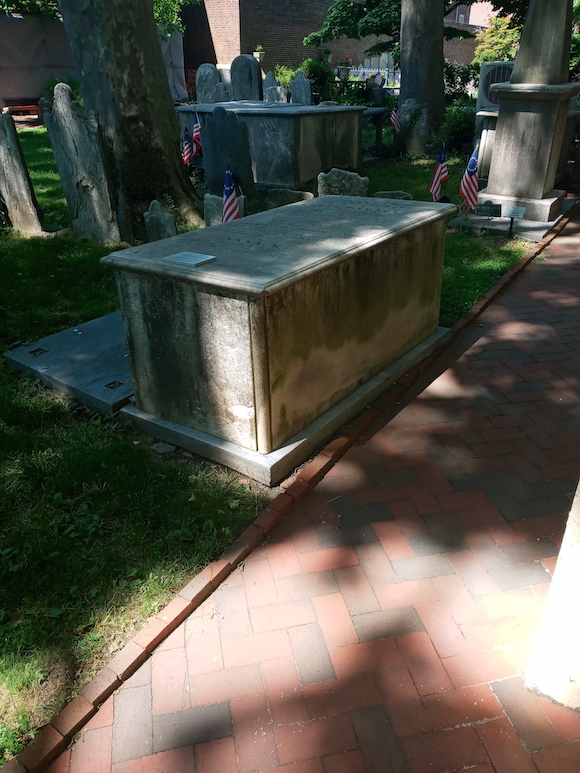The Tory in the Graveyard of Patriots
The “Church of the Patriots,” has one notable exception: George Dawson, who served in His Britannic Majesty’s efforts to suppress the American Revolution and restore British rule. Dawson was born in 1760, in New York. In the same year Patriots declared independence from Great Britain, 1776, he joined a loyalist militia unit in New York, the King’s Orange Rangers (KOR). Initially stationed in New York, desertions caused it to be transferred to Nova Scotia, in Canada. The KOR was stationed at The Citadel for the most part, and continued to be plagued by desertions and internal disputes.[1] It was here that Dawson spent much of the war and did well. He became a captain and was transferred to the British Legion on 25 August 1782.[2] The British Legion had been commanded by the infamous Banastre Tarleton, accused of atrocities during the war, including the killing Americans who had surrendered. However, Banastre no longer led the Legion when Dawson transferred, and his transfer was likely due to the fact that it had been nearly destroyed during the British campaign in the American southern states. The war ended a year later with the British signing the Treaty of Paris. The Legion was then moved back to New York, probably to aid in the British evacuation, and then back again to Nova Scotia.
After the war, Dawson settled in St. Andrews in New Brunswick, right across the St. Croix River from Maine, probably due his receiving a land grant as a reward for his service to the crown. At some point prior to December 25th, 1795, he came to the Philadelphia area; he was married here at this church on that Christmas day. He appeared as a resident and merchant in the city in 1798, in one instance attempting to sell 20,000 pounds of soap. Dawson’s mercantile activities were affected by the outbreak of the Haitian Revolution which erupted in 1791. The then French colony, called Saint-Domingue, was a battlefield for enslaved slaves liberating themselves, the French plantation owners, the Spanish on the other half of the island, and British, who warred with France for nearly twenty years. The French wanted to prevent trade with the Haitians fighting for liberation, and Dawson’s Kitty and Maria was captured by French privateers. Nevertheless, Dawson made money on the capture because he over-insured the ship and his part of the cargo therein. Although a member of the church that had been led by the Patriot Pastor George Duffield, and one visited by John Adams, the Architect of Independence, George Dawson remained true to his Loyalist beliefs - and was rewarded for his service to the Crown. Dawson named his second son George Augustus Frederick, the same name as George III’s heir and the future King George IV. Dawson’s epitaph brags about his service to “his Britannic Majesty” during the Revolution, as well as serving in the infamous Tarleton’s Legion. In addition to the land he was given in Canada, Dawson collected a pension from the British government, which no doubt helped to pay for the large and expensive tomb in the graveyard, and which passed to his wife when he died in 1832. In life and death, George Dawson is the greatest exception to Old Pine Street Presbyterian Church’s graveyard of Patriots.
Epitaph engraved on George Dawson’s tomb:
Sacred to the memory of
George Dawson, Esq.
late a Captain in Colonel Tarleton's regiment
of Light Dragoons
in the service of his Britannick Majesty
and for many years a resident of this city
who departed this life
June 1th 1832
aged72 years and 12 days
Also
George Augustus Frederick Dawson
Second son of Captain George Dawson
and Anna Maria his wife
Born November 11th 1796 died March 18th 1811
aged 14 years 4 months & 7 days
Also
Anna M.wife of George B. Dawson
departed this life June 23rd 1852
in the 76th year of her age


References
[1] Wikipedia, “King’s Orange Rangers,” https://docs.google.com/document/d/1amvyJXaSNG17nvQieQ5eSA8UJmoK0rCB47KpcxzJzoU/edit?ts=6096ae8d as of 11 May 2021.
[2] Dawson Pension, National Archives of the United Kingdom; The Online Institute for Advanced Loyalist Studies, “British Legion Biographical Sketches, Infantry Officers,” http://www.royalprovincial.com/military/rhist/britlegn/blinf1.htm as of 9 May 2021
Image credit: Kings Orange Rangers, Fort Morris, Liverpool, Nova Scotia by Hantsheroes. CC BY-SA 4.0